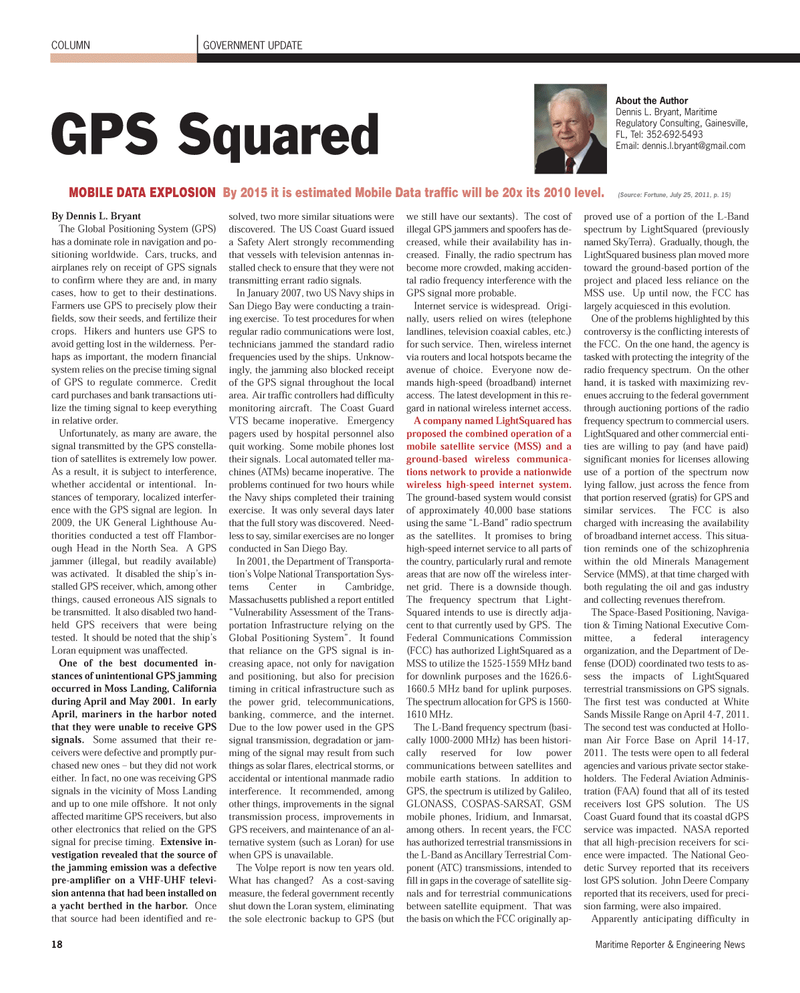
Page 18: of Maritime Reporter Magazine (August 2011)
Top 20 Shipyards of the World
Read this page in Pdf, Flash or Html5 edition of August 2011 Maritime Reporter Magazine
18Maritime Reporter & Engineering News GOVERNMENT UPDATE COLUMNGPS Squared By Dennis L. BryantThe Global Positioning System (GPS)has a dominate role in navigation and po- sitioning worldwide. Cars, trucks, and airplanes rely on receipt of GPS signalsto confirm where they are and, in many cases, how to get to their destinations. Farmers use GPS to precisely plow their fields, sow their seeds, and fertilize their crops. Hikers and hunters use GPS to avoid getting lost in the wilderness. Per- haps as important, the modern financial system relies on the precise timing signalof GPS to regulate commerce. Credit card purchases and bank transactions uti-lize the timing signal to keep everything in relative order. Unfortunately, as many are aware, the signal transmitted by the GPS constella-tion of satellites is extremely low power. As a result, it is subject to interference,whether accidental or intentional. In-stances of temporary, localized interfer- ence with the GPS signal are legion. In 2009, the UK General Lighthouse Au- thorities conducted a test off Flambor- ough Head in the North Sea. A GPS jammer (illegal, but readily available) was activated. It disabled the ship?s in- stalled GPS receiver, which, among other things, caused erroneous AIS signals to be transmitted. It also disabled two hand- held GPS receivers that were being tested. It should be noted that the ship?s Loran equipment was unaffected. One of the best documented in-stances of unintentional GPS jammingoccurred in Moss Landing, California during April and May 2001. In early April, mariners in the harbor noted that they were unable to receive GPS signals. Some assumed that their re-ceivers were defective and promptly pur- chased new ones ? but they did not work either. In fact, no one was receiving GPS signals in the vicinity of Moss Landingand up to one mile offshore. It not only affected maritime GPS receivers, but also other electronics that relied on the GPSsignal for precise timing. Extensive in- vestigation revealed that the source of the jamming emission was a defective pre-amplifier on a VHF-UHF televi- sion antenna that had been installed ona yacht berthed in the harbor. Oncethat source had been identified and re- solved, two more similar situations were discovered. The US Coast Guard issued a Safety Alert strongly recommending that vessels with television antennas in- stalled check to ensure that they were not transmitting errant radio signals. In January 2007, two US Navy ships in San Diego Bay were conducting a train- ing exercise. To test procedures for when regular radio communications were lost, technicians jammed the standard radiofrequencies used by the ships. Unknow- ingly, the jamming also blocked receipt of the GPS signal throughout the localarea. Air traffic controllers had difficulty monitoring aircraft. The Coast Guard VTS became inoperative. Emergency pagers used by hospital personnel alsoquit working. Some mobile phones lost their signals. Local automated teller ma-chines (ATMs) became inoperative. The problems continued for two hours while the Navy ships completed their training exercise. It was only several days later that the full story was discovered. Need- less to say, similar exercises are no longer conducted in San Diego Bay. In 2001, the Department of Transporta- tion?s Volpe National Transportation Sys- tems Center in Cambridge,Massachusetts published a report entitled?Vulnerability Assessment of the Trans- portation Infrastructure relying on theGlobal Positioning System?. It foundthat reliance on the GPS signal is in-creasing apace, not only for navigation and positioning, but also for precision timing in critical infrastructure such asthe power grid, telecommunications, banking, commerce, and the internet.Due to the low power used in the GPS signal transmission, degradation or jam- ming of the signal may result from suchthings as solar flares, electrical storms, oraccidental or intentional manmade radiointerference. It recommended, amongother things, improvements in the signal transmission process, improvements in GPS receivers, and maintenance of an al- ternative system (such as Loran) for use when GPS is unavailable. The Volpe report is now ten years old. What has changed? As a cost-saving measure, the federal government recently shut down the Loran system, eliminating the sole electronic backup to GPS (but we still have our sextants). The cost of illegal GPS jammers and spoofers has de- creased, while their availability has in- creased. Finally, the radio spectrum has become more crowded, making acciden- tal radio frequency interference with the GPS signal more probable.Internet service is widespread. Origi-nally, users relied on wires (telephone landlines, television coaxial cables, etc.) for such service. Then, wireless internet via routers and local hotspots became theavenue of choice. Everyone now de- mands high-speed (broadband) internetaccess. The latest development in this re- gard in national wireless internet access. A company named LightSquared has proposed the combined operation of amobile satellite service (MSS) and a ground-based wireless communica- tions network to provide a nationwide wireless high-speed internet system. The ground-based system would consist of approximately 40,000 base stationsusing the same ?L-Band? radio spectrumas the satellites. It promises to bringhigh-speed internet service to all parts ofthe country, particularly rural and remoteareas that are now off the wireless inter- net grid. There is a downside though. The frequency spectrum that Light- Squared intends to use is directly adja-cent to that currently used by GPS. The Federal Communications Commission(FCC) has authorized LightSquared as aMSS to utilize the 1525-1559 MHz bandfor downlink purposes and the 1626.6- 1660.5 MHz band for uplink purposes.The spectrum allocation for GPS is 1560-1610 MHz. The L-Band frequency spectrum (basi- cally 1000-2000 MHz) has been histori- cally reserved for low power communications between satellites andmobile earth stations. In addition toGPS, the spectrum is utilized by Galileo,GLONASS, COSPAS-SARSAT, GSM mobile phones, Iridium, and Inmarsat,among others. In recent years, the FCChas authorized terrestrial transmissions inthe L-Band as Ancillary Terrestrial Com- ponent (ATC) transmissions, intended to fill in gaps in the coverage of satellite sig- nals and for terrestrial communicationsbetween satellite equipment. That was the basis on which the FCC originally ap-proved use of a portion of the L-Band spectrum by LightSquared (previously named SkyTerra). Gradually, though, the LightSquared business plan moved more toward the ground-based portion of the project and placed less reliance on theMSS use. Up until now, the FCC has largely acquiesced in this evolution. One of the problems highlighted by thiscontroversy is the conflicting interests of the FCC. On the one hand, the agency is tasked with protecting the integrity of the radio frequency spectrum. On the other hand, it is tasked with maximizing rev- enues accruing to the federal government through auctioning portions of the radiofrequency spectrum to commercial users. LightSquared and other commercial enti-ties are willing to pay (and have paid) significant monies for licenses allowing use of a portion of the spectrum now lying fallow, just across the fence from that portion reserved (gratis) for GPS and similar services. The FCC is also charged with increasing the availability of broadband internet access. This situa- tion reminds one of the schizophreniawithin the old Minerals ManagementService (MMS), at that time charged with both regulating the oil and gas industry and collecting revenues therefrom. The Space-Based Positioning, Naviga- tion & Timing National Executive Com- mittee, a federal interagency organization, and the Department of De- fense (DOD) coordinated two tests to as- sess the impacts of LightSquaredterrestrial transmissions on GPS signals.The first test was conducted at White Sands Missile Range on April 4-7, 2011. The second test was conducted at Hollo- man Air Force Base on April 14-17, 2011. The tests were open to all federal agencies and various private sector stake- holders. The Federal Aviation Adminis- tration (FAA) found that all of its tested receivers lost GPS solution. The US Coast Guard found that its coastal dGPSservice was impacted. NASA reported that all high-precision receivers for sci- ence were impacted. The National Geo- detic Survey reported that its receivers lost GPS solution. John Deere Company reported that its receivers, used for preci- sion farming, were also impaired. Apparently anticipating difficulty in About the AuthorDennis L. Bryant, Maritime Regulatory Consulting, Gainesville,FL, Tel: 352-692-5493 Email: [email protected] DATA EXPLOSION By 2015 it is estimated Mobile Data traffic will be 20x its 2010 level. (Source: Fortune, July 25, 2011, p. 15) MR Aug. 11 # 3 (18-24):MR Template 8/3/2011 10:19 AM Page 18

 17
17

 19
19
